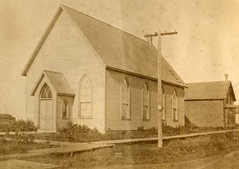 |
Flora Bockwitz in her youth [Photo Courtesy: Bob Bockwitz] |
This is Flora Elizabeth Woll Bockwitz. According to her grandson, Bob Bockwitz, Flora had a rather unique skill set. She was a
sharpshooter...
From a
historical essay about her, comes this quote, from a 1971 interview of her son, Virgil Bockwitz:
One of the best lady sharp shooters, Flora Elizabeth Woll Bockwitz pioneered in Kittson County. She could match skills with anyone. She could shoot a cigarette out of her husband's mouth. This trick challenged and excited everyone.
Flora acquired this unusual skill at the age of 15. In her childhood days, such things weren't done by girls. However, this didn't bother Flora. She learned how to shoot and ride horseback better than most boys. She used the shotgun and rifle. Every time her pa went out hunting, she was right behind him.
Even after marriage she kept up this hobby. She and her husband represented some of the leading manufacturers of shotguns and rifle ammunition.
The couple made runs on the Mississippi River steamboats and made showings of their great rifle and shotgun skills. One of the ammunition companies they traveled for was the Peter's Company.
 |
Flora takes aim at
tonight's supper...
[Photo courtesy: Bob Bockwitz] |
She could shoot a hundred clay pigeons without missing a shot. She used a .22 calibre rifle in this trick. She could also shoot the tiny briquettes, as they were thrown up in the air.
The neighbors still can see her coming out of her kitchen door and shooting a chicken running across the yard at full speed. She then picked the chicken up and took it in the house and plucked and cleaned it. Then, when the men came for supper they had fresh fried chicken.
I'd say that's pretty impressive...and I'm just talking about the plucking and frying up part - I have a hard enough time having enough energy to defrost meat in the microwave and cook it up after a day's work. But then, I suppose hard work and hunger are powerful motivators to get a meal made!












